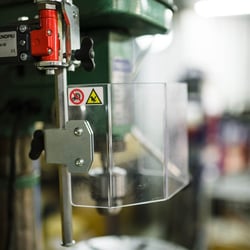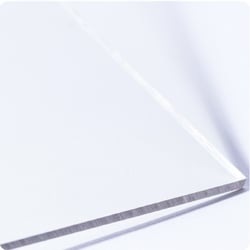Although polycarbonate and acrylic have similar properties and look virtually the same, they are two different materials. Acrylic is better known under the trade name Plexiglas, while polycarbonate is commonly referred to as LEXAN, both of which are registered trademarks.
Since both are clear plastics, they can be quite difficult to differentiate. One easy trick is to look at the edge of the material; polycarbonate is bluish, while acrylic is almost transparent. Of course, this technique is not infallible, but it gives you a good clue as to which is which.
Polycarbonate and acrylic, what is the difference?
When speaking of the hardness of a material, we are commonly referring to its mechanical resistance. The latter is in fact a combination of several types of resistance: compression, bending, traction and shear. Also, hardness is not to be confused with impact resistance. The best example of this is glass, an extremely hard material with a relatively low impact resistance. It is therefore wrong to assume that a material’s hardness reflects its ability to withstand impacts. Contrary to popular belief, acrylic is much harder and stiffer than polycarbonate. It is, however, less resistant to impacts. In fact, polycarbonate is 250 times more resistant to impacts than standard glass, while acrylic is only 17 times more resistant.
Applications and properties of polycarbonate
 Due to its high impact resistance, polycarbonate is an ideal solution for demanding applications. It is therefore often used in the manufacturing of safety panels and glazing. This material is also available in bullet-proof grade. Polycarbonate is frequently used to manufacture factory safety panels, machine guards and Bullet-proof glazing.
Due to its high impact resistance, polycarbonate is an ideal solution for demanding applications. It is therefore often used in the manufacturing of safety panels and glazing. This material is also available in bullet-proof grade. Polycarbonate is frequently used to manufacture factory safety panels, machine guards and Bullet-proof glazing.
Polycarbonate has a transparency index of 0.86, compared to 0.92 for acrylic. So, although polycarbonate is transparent, its optical properties are inferior. Polycarbonate therefore tends to distort objects when viewed through at an angle or diagonally. However, this distortion is not an issue when looking through it from the front.
Acrylic applications
 With its higher transparency index than polycarbonate and its excellent optical properties, acrylic is an ideal solution for the manufacture of protective screens (to reduce the risk of contamination, for example). On the other hand, for security screens, its impact resistance is much lower than polycarbonate. The transparency index of acrylic (0.92) is even higher than that of glass, which is between 0.80 and 0.90. This makes it a better choice for applications that require good optical clarity and a high level of transparency.
With its higher transparency index than polycarbonate and its excellent optical properties, acrylic is an ideal solution for the manufacture of protective screens (to reduce the risk of contamination, for example). On the other hand, for security screens, its impact resistance is much lower than polycarbonate. The transparency index of acrylic (0.92) is even higher than that of glass, which is between 0.80 and 0.90. This makes it a better choice for applications that require good optical clarity and a high level of transparency.







